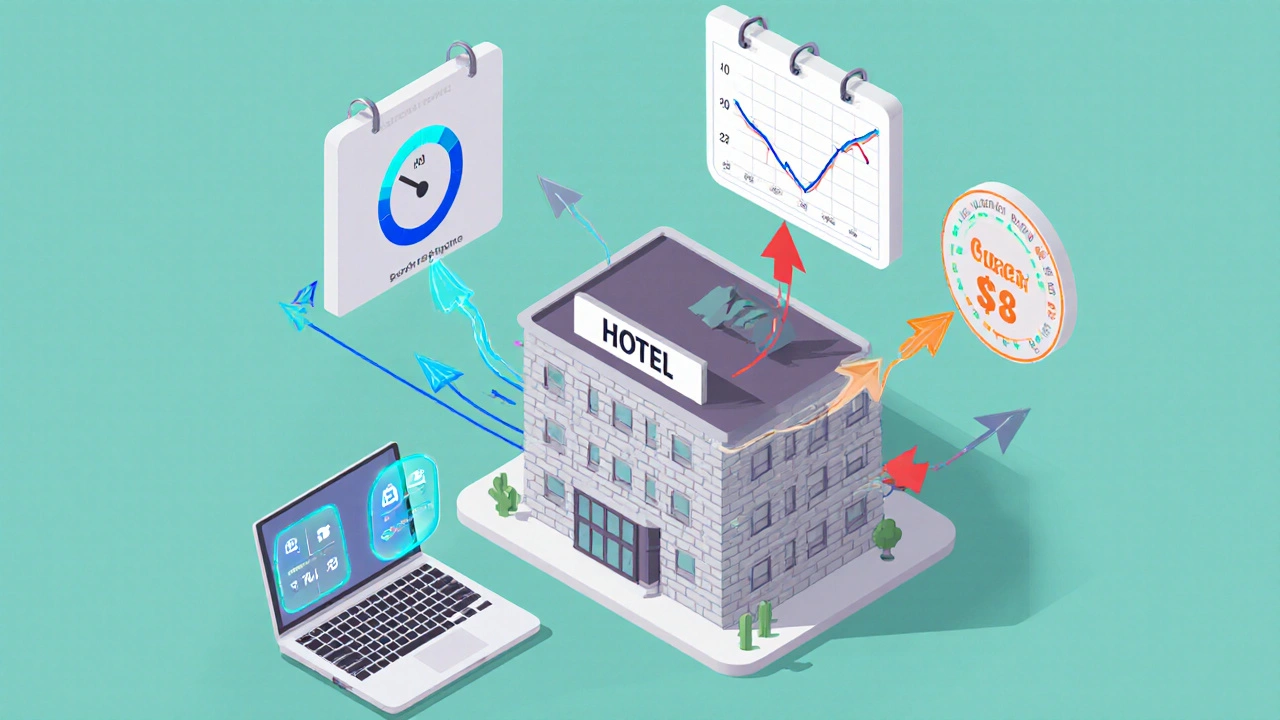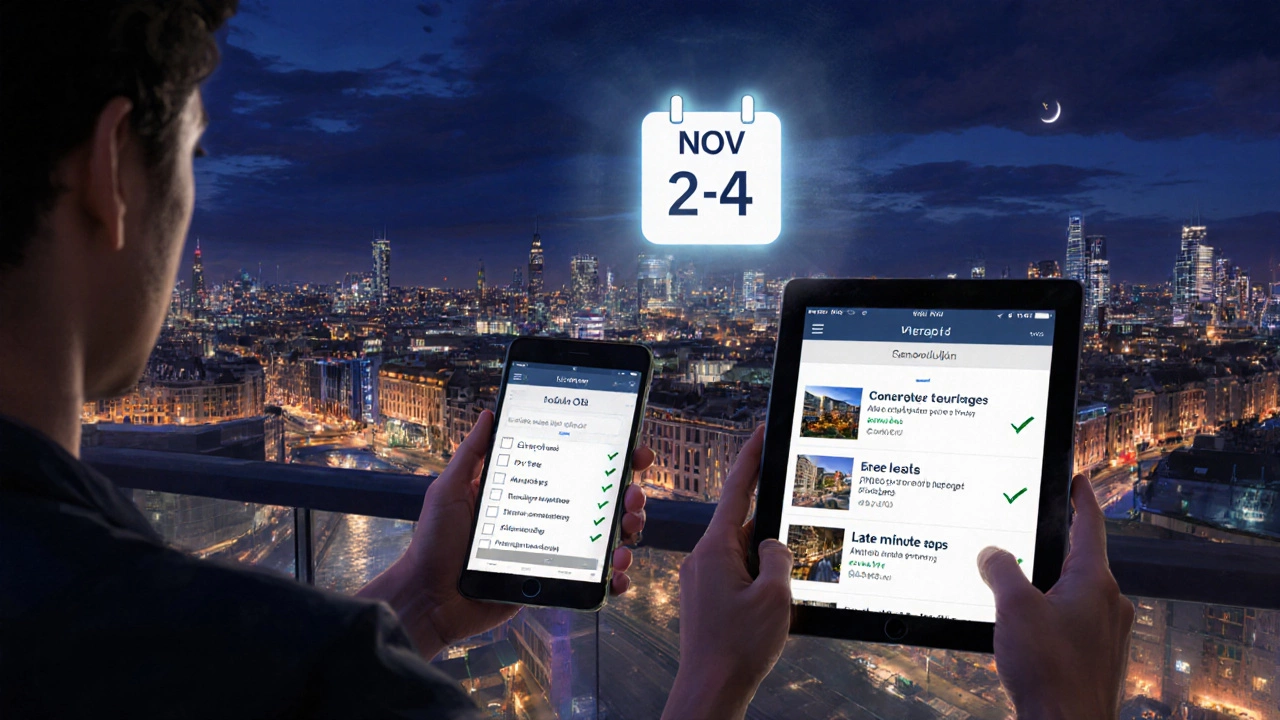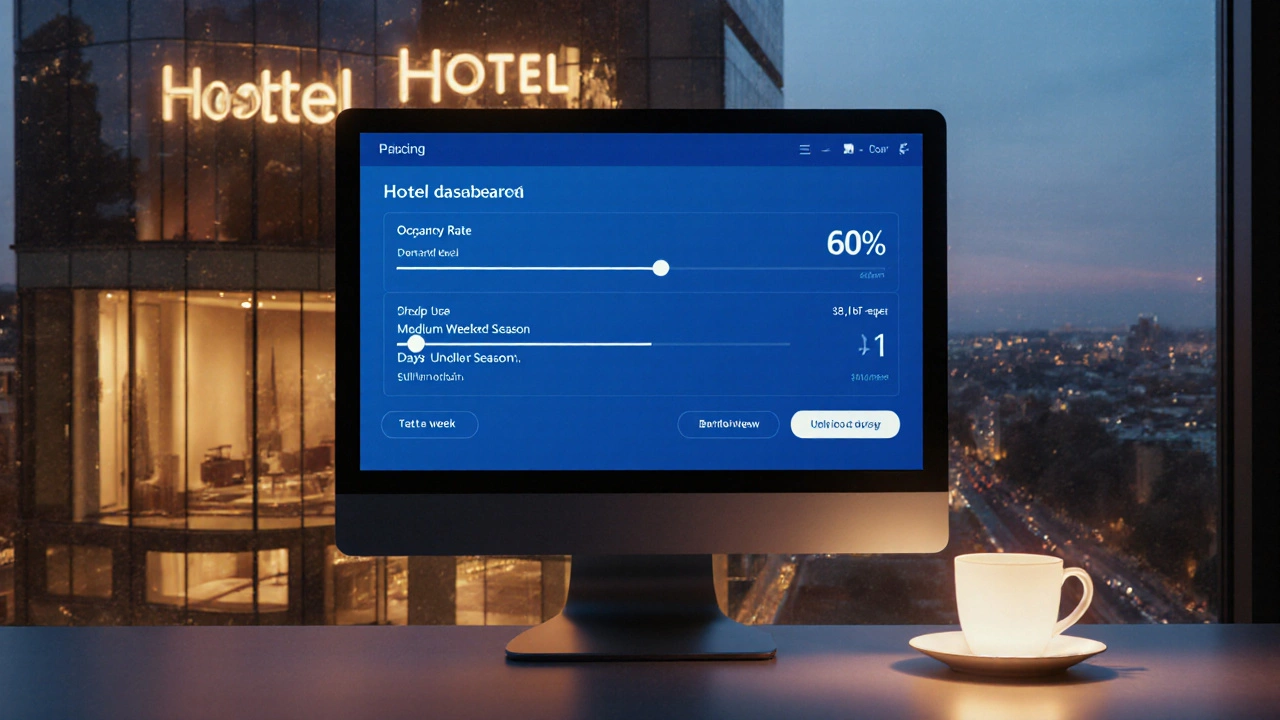Hotel Price Trend Predictor
Enter values and click "Predict Rate Change" to see the forecast.
How It Works
This tool analyzes key factors affecting hotel rates:
- Occupancy Rate: Lower occupancy increases chance of last-minute discounts
- Demand Level: High demand often leads to rate increases
- Time Until Check-in: Shorter timeframes allow less room for rate adjustments
Note: Actual rates depend on many other factors including hotel policies, room type, and specific booking channels.
Quick Takeaways
- Hotel ratesaredynamic; they can fall, stay flat, or rise as your stay date approaches.
- Last‑minute discounts happen mainly when occupancy is low or when a hotel wants to fill unsold rooms.
- Use multiple channels - direct hotel sites, OTAs, and dedicated last‑minute apps - to compare prices.
- Flexible dates, incognito browsing, and loyalty programs boost your chances of snagging a cheaper room.
- A quick checklist at the end helps you act fast without paying hidden fees.
How Hotel Pricing Works
When you start searching for a place to stay, you’re entering a market driven by dynamic pricing a pricing strategy that changes rates in real time based on supply, demand, and a host of other factors. Hotels feed their inventory into a booking engine software that calculates the optimal price for each room night, taking into account competition, events, and historical data. The engine continuously updates the hotel room rate the price you see when you look at a specific room type for a given night.
Two core metrics steer the algorithm:
- Occupancy - the percentage of rooms already booked. High occupancy pushes prices up; low occupancy can trigger discounts.
- Seasonal demand - holidays, conferences, or local festivals that spike demand for a short period.
The goal is simple: maximize revenue per available room (RevPAR). That means hotels will sometimes raise rates right before a big event, but they’ll also slash them if they see a wave of empty rooms a week away.
What Happens to Rates As Your Check‑In Date Gets Closer?
There’s no single rule that fits every property, but three common patterns emerge:
- Early‑bird discount - When a hotel opens its inventory months in advance, it often offers a lower rate to lock in bookings. This is why you sometimes see a 20% discount for a stay booked 90 days out.
- Last‑minute dip - If occupancy is still below target a few days before arrival, the system may automatically lower the rate to fill rooms. This is the sweet spot for the savvy traveler who can wait.
- Price surge - During high‑demand windows (e.g., a city hosting a major concert), rates can climb sharply even on the day of arrival because the hotel knows it can sell rooms at premium prices.
Data from a 2024 study of 1.2million hotel bookings in Europe showed that, on average, rates fell by 8% in the 48‑hour window before check‑in when occupancy was below 70%, but rose by 12% when occupancy exceeded 90%.

When Are Hotels Likely to Offer Cheaper Rates?
Knowing the market forces helps you spot the moments when hotels are most motivated to cut price:
- Mid‑week stays - Business hotels often have high occupancy on weekdays but struggle on weekends. Booking a Tuesday night in a city that’s busy Monday‑Friday can land you a lower rate.
- Off‑season travel - Visiting a beach resort in October instead of July usually means lower rates because demand drops.
- Last‑minute cancellations - When a large group cancels, hotels scramble to re‑stock rooms. This creates a narrow window for discounted rates.
- Special promotions - Many chains run flash sales on their own website to drive direct bookings and avoid OTA commissions.
Conversely, if you’re traveling to a city during a major conference, expect rates to stay high even a day before arrival.
Best Ways to Find a Cheaper Rate
There are several channels you can tap, each with its own pros and cons. Below is a quick comparison.
| Channel | Typical price advantage | Extra fees | Cancellation flexibility | Loyalty points |
|---|---|---|---|---|
| Direct hotel website | 5‑10% lower (flash sales) | None or low | Varies - often stricter | Full brand points |
| Online Travel Agency (OTA) | 0‑5% lower (price‑match guarantee) | Service fee 2‑4% | Usually free cancellation up to 24h | OTAs may have their own points |
| Last‑minute app (e.g., HotelTonight) | 10‑30% lower on unsold rooms | Minimal - often no extra fee | Often non‑refundable | Rarely offers loyalty points |
To make the most of these options, follow a simple routine:
- Set up price alerts on at least two platforms (e.g., Google Hotels and a dedicated OTA).
- Check the hotel’s own site for flash sales - they sometimes beat the OTA price by a small margin.
- If you’re flexible, search for rooms on the day of stay using a last‑minute app. Expect the biggest discounts but be ready for a stricter cancellation policy.
- Clear your cookies or use incognito mode before each search. Some sites raise prices when they detect repeated visits.
- Join the hotel’s loyalty program. Even free members often receive a “member‑only” rate that’s a few percent lower.
When you finally spot a deal, act fast - these lower rates can disappear within minutes once the inventory updates.
Common Pitfalls to Avoid
Even when you find a lower rate, a few hidden traps can turn a good deal into a costly mistake:
- Hidden taxes and resort fees - Some platforms display a “base rate” that looks cheap, but the final price after taxes, city taxes, and resort fees can be higher than a more transparent offer.
- Non‑refundable bookings - Last‑minute apps often sell rooms as non‑refundable. If your plans change, you lose the money.
- Room quality mismatch - A deep discount may apply to a different room type (e.g., a smaller or lower‑floor room). Double‑check the room description.
- Currency conversion fees - Booking on a foreign‑language site may add conversion fees you won’t see until checkout.
Read the fine print, and always compare the total cost, not just the nightly rate.

Last‑Minute Booking Checklist
Keep this short list handy on your phone before you hit “Book”:
- Is the hotel’s occupancy likely low? (Check recent booking trends on Google Hotels.)
- Have you cleared cookies or opened an incognito window?
- Did you compare at least three sources (direct, OTA, last‑minute app)?
- Are all taxes, fees, and optional extras included in the displayed price?
- Does the cancellation policy match your flexibility needs?
- Do you earn loyalty points or other perks with this booking?
If you can answer “yes” to most of these, you’re probably getting a solid deal.
Real‑World Example: Dublin in Early November
Imagine you’re flying to Dublin for the St.Patrick’s Day parade prep, but you plan to stay on November2‑4, a low‑demand period. You check three channels:
- Hotel’s own site offers a standard rate of €120 per night, with a 10% discount for loyalty members - total €108.
- OTA shows €115 but adds €12 in city tax and €5 resort fee - total €132.
- Last‑minute app lists a “last‑minute” room at €95, non‑refundable, with no taxes displayed.
After confirming the total cost, you realize the OTA price is higher due to fees. The direct‑book option gives you points and free cancellation, while the last‑minute app saves you €13 but locks you in. If your schedule is firm, you’d pick the €95 deal; if you need flexibility, the €108 loyalty rate wins.
Bottom Line
Hotels don’t follow a simple rule that they always get cheaper the closer you get. Rates dip when occupancy is low, when hotels need to fill rooms, or when they run flash promotions. They spike when demand is high or events are imminent. By understanding the forces behind hotel prices last minute, using multiple booking channels, and checking the fine print, you can consistently snag better deals without surprise charges.
Frequently Asked Questions
Do all hotels lower prices a day before check‑in?
No. Hotels only lower rates when they still have unsold rooms and expect that a discount will fill them. In high‑demand periods, rates often stay the same or rise even a few hours before arrival.
Is it better to book directly with the hotel or through an OTA?
It depends. Direct bookings can give you loyalty points and occasional flash‑sale rates, while OTAs provide price‑match guarantees and flexible cancellation. Comparing both is the safest bet.
How can I see if a hotel’s occupancy is low?
Use tools like Google Hotels or Kayak that show a ‘price trend’ bar. If the bar is green or yellow, occupancy is likely below 70%, increasing the chance of a discount.
Do last‑minute apps charge hidden fees?
Most reputable apps include taxes and fees in the displayed price, but always double‑check the final checkout total. Some smaller regional apps might add a service charge.
Can I combine a loyalty discount with a last‑minute deal?
Usually not. Loyalty discounts are applied only on direct bookings, and last‑minute apps typically sell rooms at their own discounted rate without stacking other promotions.
